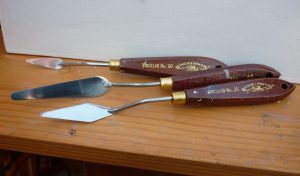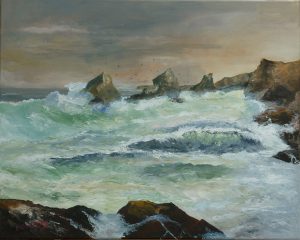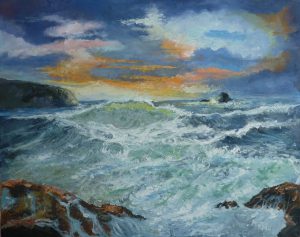Palette knife

The last two paintings I did was a combination of brush and palette knife, I find using the knife helps to create movement and a 3D effect particularly for sea and mountain scenes, this is achieved by adding dabs of paint on its side and maneuvering your hand and arm in the direction of the waves or mountains being painted. Under painting isn’t necessary with this technique. Try scraping out an area of wet paint you don’t like, which has the added benefit of creating interesting texture. For the most part I add more paint on top and enjoy how it interacts with the paint below, this also depends on how much pressure you put on the knife and following the direction of the waves when painting a seascape.
There are many painting knives available I prefer the smaller type with a straight side this type is used by many Russian artists, I prefer the lighter springy and flexible type. Try to find a knife you like and learn to use it well, pick up the paint using the side place the paint on the portion of the knife you want to pull the paint from.
Cleaning the knife after each application to the painting is very important this is achieved by wiping the blade with a paper towel before putting more paint on the knife blade.
I used acrylic for these two paintings but the type that can be regenerated by spraying the paint with a water spray to keep the paint from drying to quickly.
The acrylic paint I like is the Interactive Atelier this paint can be adjusted and blended longer and will not dry as long as you spray the paint with water as soon as it begins to loose its flexibility it is very much like painting with oil paint with out the smell and long drying time.


I have put the paintings on and also some of my palette knives, thanks for all your comments good painting
Cheers Phil
Click this video for a demo of the Palette Knife.